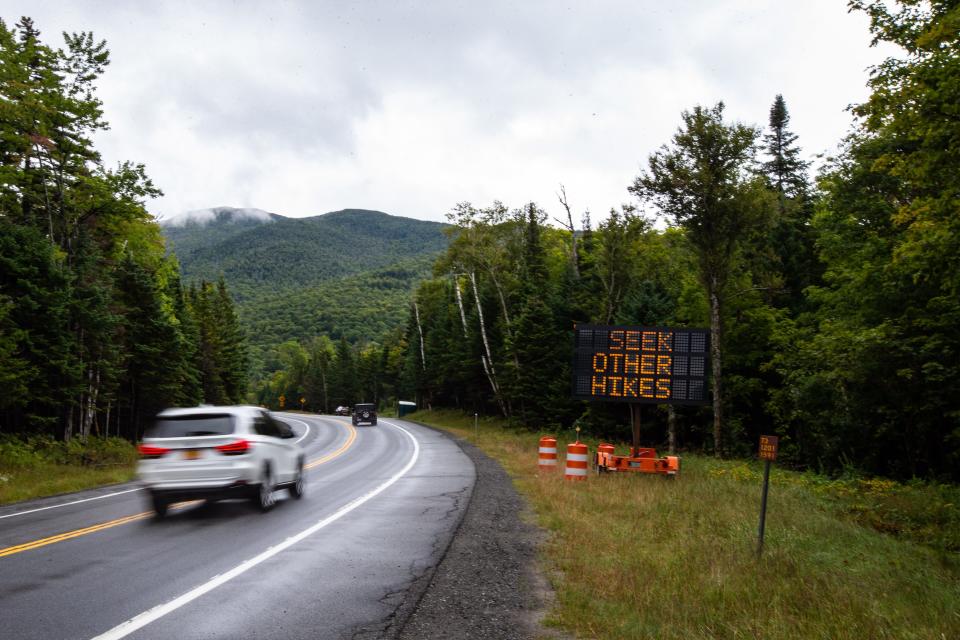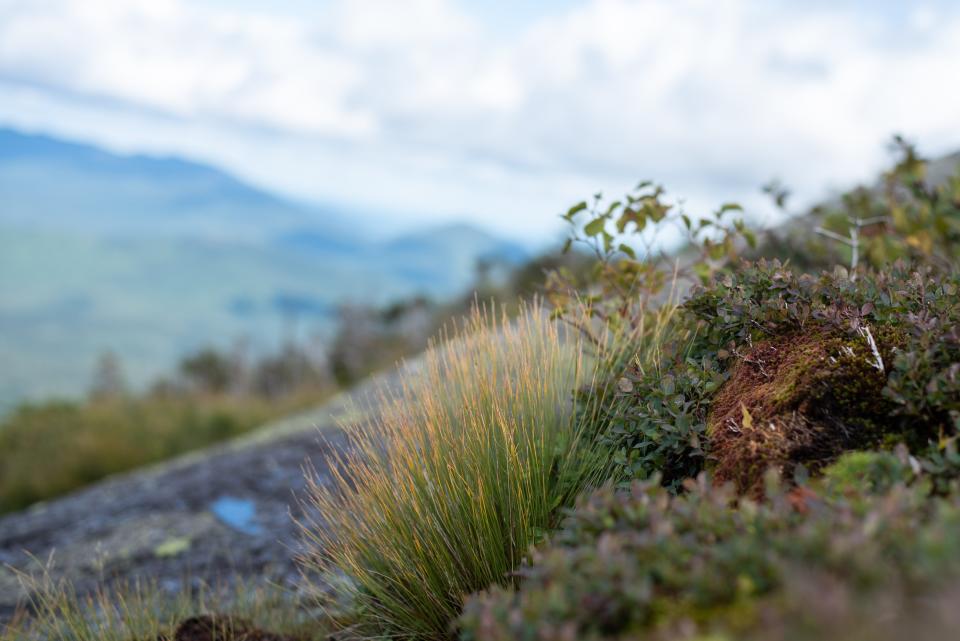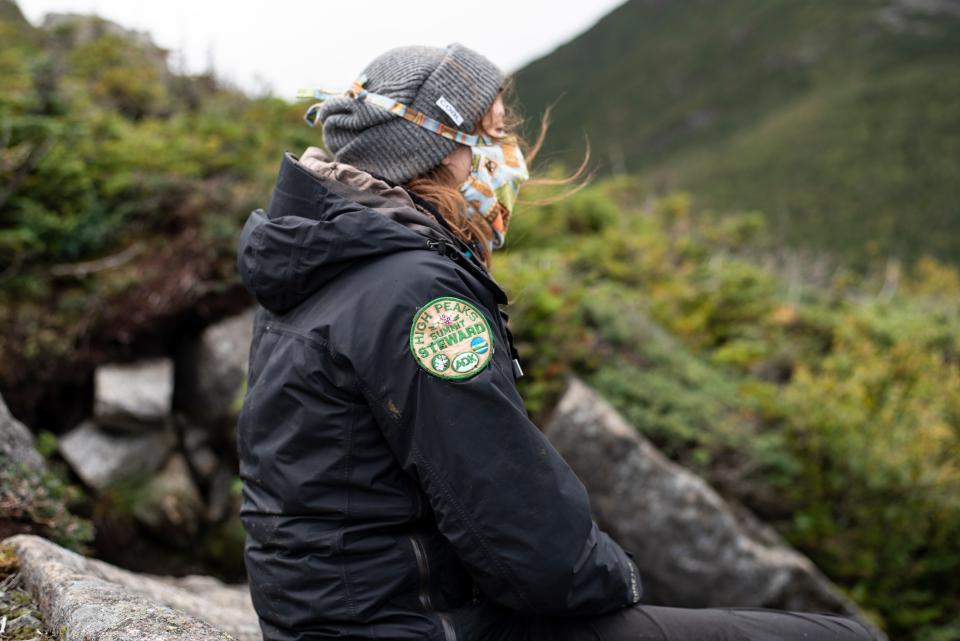Planning on hiking in upstate New York's Adirondacks this fall? Expect a crowd
LAKE PLACID, N.Y. — Most days this summer, long before the sun peeks out over the tops of the Adirondack Mountains, the parking lot at the Adirondack Loj trailhead is full.
The spots in the gravel lot, some 200 of them, quickly fill with cars. Out spill ambitious hikers, many experienced and dressed in layers, with hiking boots and rain jackets and light backpacks filled with food and water.
But lately, there's another kind of hiker. The kind of person who gets out of the car wearing Crocs or flip flops, and plans on using their cell phone to navigate the trails during their hike.
Overcrowding along trails in the vast Adirondacks has been a growing problem for years, and it's been exacerbated this year by the COVID-19 pandemic as travelers stay within driving distance of their homes and seek safe, outdoor activities.
Monitoring and supporting new visitors has long been a mission for various Adirondack organizations. And this year, education has become more important than ever.
Stu Weinberg, a retiree who volunteers with the Adirondack Mountain Club, sometimes is tasked with "hosting" — greeting people as they arrive, asking where they're headed and assessing their level of preparedness.

He's not there to reprimand them, he said. It's more so about educating people, and giving them a bit of a reality check before they head off.
"Many people see a nice picture on Instagram and go, 'Oh, we should do that' and really don't do the research or have an understanding of what's involved," Weinberg said. "(We're) seeing the lack of experience — or, how many new people there are."
Last summer was hectic like this, too, Weinberg said. But with COVID-19 thrown into the mix and outdoor spaces deemed safe spaces, the Adirondack Park has seen a huge increase in visitors in the last few months.
It's normal for the parking lot at the Loj (pronounced "lodge") to fill up early on the weekends. But this year, Weinberg said, it's been a daily occurrence — even without the additional Canadian hikers they'd normally have this time of year.
"In the media, being outdoors is one of those things that's 'good' to do during the pandemic," he said. "A lot of people who have never been in the outdoors before are now doing it."
And that's not necessarily a bad thing, he said. More use and more positive experiences helps the park in the long run, especially when it comes to preservation and donations.
The problem, locals say, is that leaf peeping season has just begun. It's the time of year when the fall colors emerge, painting an already beautiful landscape in hues of orange and red and yellow.
And it also means plenty of people to dot the mountain views.
Being Black in the Adirondacks: Why the drive to boost diversity is complex, and personal
Navigating peak popularity
Tourism in the Adirondack Park generates more than $1 billion in economic impact annually, and an estimated 12.4 million people visit each year.
The Adirondack Park encompasses some six million acres in the North Country. A big draw are the High Peaks — 46 of New York's tallest mountains, mostly in and around Essex County. Those who hike all of them call themselves 46ers.
The hikes are challenging, but the views are stellar.
In the last few years, spectacular photos from the summits of peaks like Algonquin, Marcy and Cascade have started to flood social media sites. Searching through posts with these locations tagged produces an endless stream of pictures of hikers with wide smiles posing in front of 360-degree mountain views.
The right kind of busy ⛰ . . Gray, Skylight, Marcy ✅
A post shared by Kelly Davis 🌅🍹💋 (@kdavis11kdavis) on Aug 30, 2020 at 4:11pm PDT
Trying to identify the single reason why there's been such an uptick in visitors to the High Peaks region in the last few years is simple, said Jim McKenna, CEO of the Regional Office of Sustainable Tourism in Lake Placid.
It all comes down to social media.
"The fact that the High Peaks is clearly the icon of Adirondack hiking — everybody wants to do it," McKenna said. "We're not really focusing on marketing the High Peaks — they market themselves, so to speak. And social media has certainly made that much more of an issue than it has historically."
Coupling FOMO (a social media term short for "Fear Of Missing Out") with health officials and government leaders encouraging people to exercise outdoors during the pandemic set the picturesque Adirondacks up for a busy summer — and soon fall.
Parking lots adjacent to hiking trail heads are often overflowing, with cars spilling out far beyond the allotted spaces and down the road. Trails themselves are crowded and busy. Hikers have to step off to the side to let others pass by, and masks are hit or miss.

Portable LED signs down the road from the Cascade Mountain trail on State Route 73, for example, even urge cars passing by to find another activity.
"HIKER PARKING LIMITED," the sign flashes in bright orange lights. "SEEK OTHER HIKES."
It's difficult (and likely impossible) to pinpoint the exact number of visitors to the Adirondack Park in a given season, though McKenna said examining occupancy tax collections can help create a clearer picture.
This year, he said, those taxes dipped in March, April and May about 78% below what they were in 2019. In June and July, the difference has only been about 10%. He expects the data from this August to be comparable to last year, but hasn't gotten those numbers yet.
In January, Gov. Andrew Cuomo said the state would develop “a framework to balance public use needs, working in collaboration with the State’s newly formed Adirondack High Peaks Strategic Planning Advisory Group.”
The move was applauded by Park advocates who have long clamored for more state attention to the overcrowding problem. The state has bolstered parking enforcement and sought to cut down on hikers stomping outside designated trails.
“The surge in demand for Adirondack Park open space highlights the need for the state to continue and intensify the progress it has made in curbing overcrowding and overuse on the park’s most popular trails, campsites and destinations,” Adirondack Council executive director William Janeway said in a statement.
The attraction to the Adirondacks this year is fueled by more Americans visiting, he said, as the border restrictions due to the pandemic have barred Canadians from entering the country.

Also, more homes are being bought to escape high-congestion areas, and those who already owned second homes upstate retreated to those more remote abodes and have stayed in the area through the pandemic, Janeway said.
“Better education, parking enforcement, investments in infrastructure, additional personnel and limits on use such as parking reservations all need to be part of the solution to this escalating problem," he said.
The challenge Adirondack leaders have ahead is twofold, McKenna said: How do you make sure you help new and returning visitors experience all the Adirondacks have to offer, while also preserving and protecting all the wild and natural things that make the Park so great?
"It’s a difficult one to get the right balance, but I think we’re headed in that direction," he said.
More: How much is too much? In the Adirondacks, as trail use surges, we have to wonder
More: Cuomo outlines improvements for Adirondacks
Preservation and protection by stewards

On a cloudy Sunday last month, Kayla White sat bundled up at the summit of Wright Peak. A thick jacket, windproof pants and a gray knit beanie protected her from the gusts that whipped her hair around her face, cold and intense at the bare mountaintop.
White works as a summit steward coordinator for the Adirondack Mountain Club. The role of a summit steward, she said, is primarily to protect fragile alpine vegetation that grows on 21 of the Adirondack summits.
The plants — delicate flora like alpine bilberry, three-toothed cinquefoil and deer's hair sedge — are designed to withstand cold temperatures and harsh weather.
They can't, however, survive being trampled by humans.
"Whenever you hop above treeline, you get this really fragile arctic (vegetation) left from when the glaciers were here," White said. "So the glaciers carved out this whole area and 12,000 years ago as the glaciers retreated, these alpine plants were the first things to recolonize."
Stationed at the top of some of those mountains, summit stewards will greet hikers and spend a few minutes chatting with them about their hike, the view and the alpine vegetation. They'll encourage hikers to walk only on the bare rocks and avoid stepping on or pulling on fragile plants.
But this year, COVID-19 has changed her job in many ways.

First, the pandemic shifted state budgets and put funding for the program on hold, White said. The Summit Stewardship program functions as a partnership with the state Department of Environmental Conservation and the Nature Conservancy and relies on state funding.
"The Adirondack High Peaks Summit Stewardship program has always kind of struggled with funding," White said. "This year, all of the New York state contracts were put on hold in the beginning of this season, so we were very unsure if we were even going to get funding. We were lucky that our contract actually did just go through."
While the group ultimately did receive funding, it wasn't able to fill typical seasonal positions by hiring additional summit stewards. And on top of that, the number of hikers in 2020 greatly increased in the summer months.

Some peaks, White said, will see several hundred people each day, especially on the weekends. Cascade Mountain, one of the less-strenuous high peaks, might see as many as 700 people on a weekend day with good weather.
White wears a mask while she's working, but sometimes that's not enough. Because of how populated it is, summit stewards don't staff Cascade anymore on the weekends, she said. It just isn't safe or even possible to talk with everyone that hikes it.
She's also grappling with the different types of hikers making their way to the summit.
People with no prior knowledge about trail use, cleaning up after themselves or preparing for a challenging hike are much more common on the trails than they've been in recent years.

"The hikers who are coming here this year because of COVID is definitely very different from the hikers we've experienced in the past," White said.
"A lot of people who are coming — it's definitely their first time. They're completely new to hiking or new to the area, so they do not have that knowledge of 'Leave No Trace' ... That's why it's so important for educators to be out here."
For avid hikers Mike and Katya Cassella, they've watched as first-timers flooded popular trails this summer.
In their recent trips up to the region from their home in Albany, Mike Cassella said he and his wife have had to park more than a mile down the road from where the trail even begins, behind a long line of vehicles with license plates from all over.
The Cassellas, who hike three or four high peaks each year as they steadily work on becoming 46ers, said they've seen a lot of folks who looked sorely under-prepared for the demands of hiking a High Peak.
"Yeah, (we've seen) a lot of people who looked like they just saw an Instagram picture ... and they came up in a golf shirt and loafers and a small bottle of Poland Spring, and they're trying to hit Mount Marcy on a hot day," Mike Cassella said. "I don't know what became of those people but they did not make the peak, I guarantee that."

Katya Cassella nodded in agreement, but said that there are positives to people exploring the Adirondacks who might not have before the pandemic.
"Its good that people are getting outside, that more people are getting active and enjoying nature," she said. "I just hope people, whatever they bring, they take away and be respectful to the mountains."
Building that appreciation and respect for wild spaces takes time, and the Cassellas have had a chance this summer to witness the latest challenge to the age-old dilemma of simultaneously protecting and promoting the Adirondacks as new visitors discover the region during the pandemic.
"It's twofold, and I think this debate's been going on in the Adirondacks forever," he said. "On one hand, it's great to see smaller towns ... get some business in. But then do you get to a point where there's over-usage and the trampling of the landscape? So it's a double-edged sword."
Efforts to limit parking, encourage hikers to seek out less-used trails and having summit stewards on some of the more popular hikes are simple, but hopefully effective ways of doing that.
And sometimes, there are days when people like Kayla White feel like they're really able to make a difference.
Having meaningful conversations with first-time hikers is rewarding, and she enjoys being a small part of their experience in the Adirondacks. Teaching people about protecting fragile vegetation or seeing the joy in their faces when they look out at the view is one of the best parts of the job.
And, if anything, she's hoping that they'll find a new appreciation for the Adirondacks — and want to become stewards for it, too.
"We are seeing damage to the resource because you have a lot of people who are new to the area and new to hiking," White said. "So that is definitely unfortunate, but it just means that the work that we do is even more important."
More: In rural NY, students and workers need high-speed internet amid COVID. But these barriers remain
More: Reopening NY: Saratoga Springs community races to help businesses amid COVID-19 shutdown
GSILVAROLE@Gannett.com
Georgie Silvarole is a backpack reporter for the USA TODAY Network's New York State Team. You can reach her by email or follow her on Twitter @gsilvarole.
This article originally appeared on New York State Team: Hiking in the Adirondacks this fall? You won't be alone

